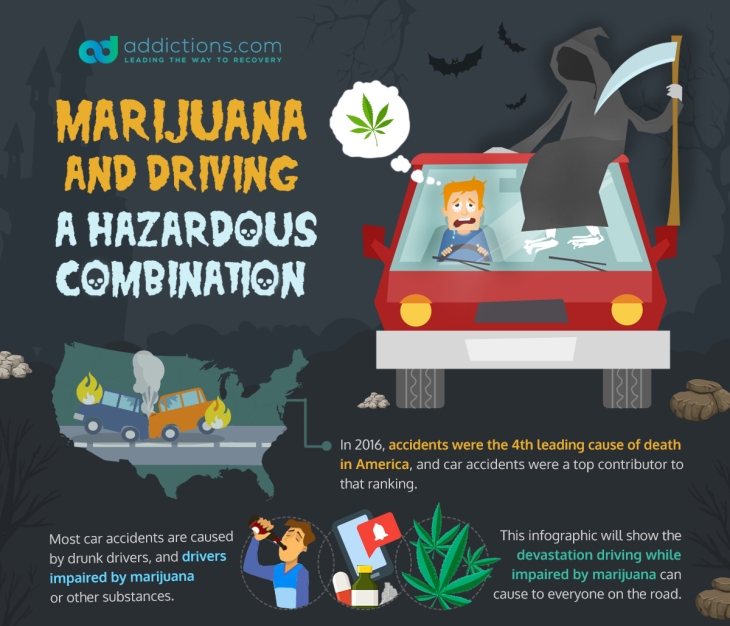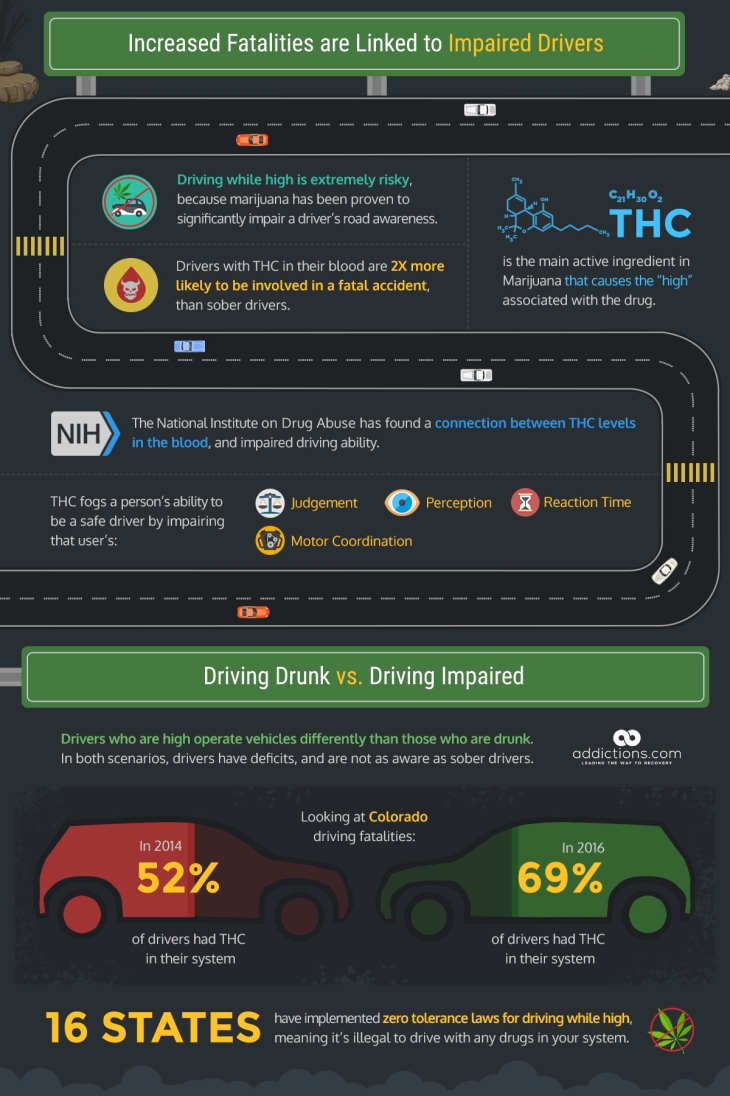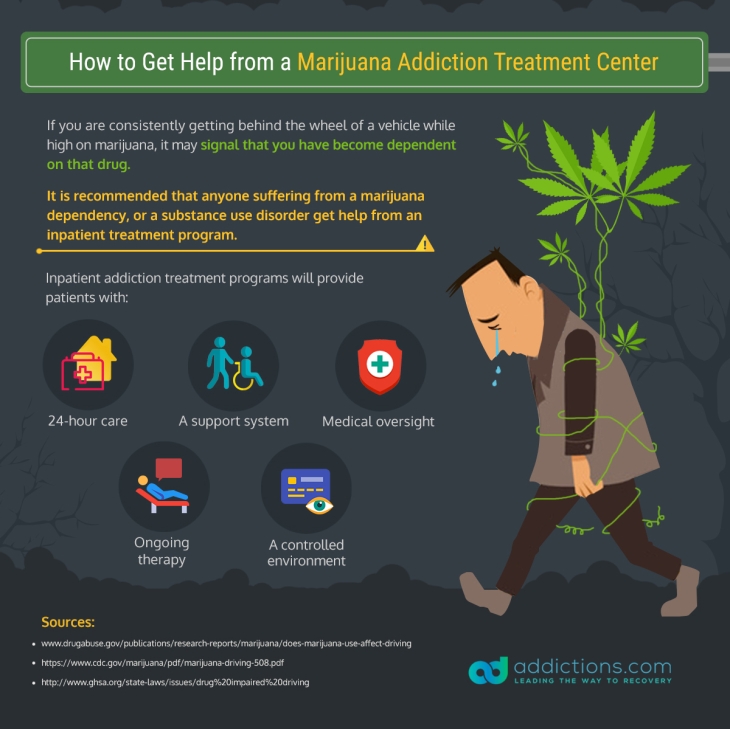Now that marijuana use is legal in many parts of the United States, a higher number of Americans are driving while high, or under the influence. Many advocates for marijuana tend to argue that driving while high is less risky, and causes fewer auto-related deaths, than driving while intoxicated by alcohol, but evidence shows that driving while high on marijuana may be just as dangerous as driving while drunk. Therefore anyone who uses this substance should be informed of the possible risks before getting behind the wheel.
How exactly does marijuana affect driving? Here’s an in-depth look at the way marijuana affects the way you drive, how it compares to the effects of alcohol, and the penalties for being caught driving while high in America.
Effects of Marijuana and Illicit Substances on Driving
Marijuana affects each person differently based on factors such as the person’s tolerance, and the strain and potency of the marijuana being used. Many people who use marijuana experience a sense of relaxation, along with heightened sensory perception and an altered perception of time. Adversely, some users may also experience panic, fear, anxiety, and psychosis — especially those who use unusually potent strains of marijuana or large amounts that their bodies are unable to handle.
Each of the effects produced by marijuana can compromise one’s ability to drive safely. Feelings of relaxation can delay reaction time on the road, while heightened sensory perception can interfere with one’s hearing and vision. An altered sense of time and distance may cause some to drive more slowly and far under speed limits, while panic can further contribute to delayed reaction time and poor decision-making.
Delusions and hallucinations that stem from psychosis may cause drivers to swerve or drive erratically — increasing the risk for auto accidents while high. Since marijuana significantly impairs judgement, those who are too impaired to drive may feel overly confident about their driving abilities and get behind the wheel anyway, largely unaware they are putting themselves and others at risk.
Marijuana is not the only drug that can impair one’s driving. Stimulants like cocaine and methamphetamine can cause drivers to become more aggressive and reckless behind the wheel, while illicit opioids like heroin can cause blurred vision and extreme drowsiness. Misuse of prescription drugs including benzodiazepines, barbiturates, painkillers, and stimulants can also increase the risk for auto-related accidents, as these drugs produce various effects that strongly interfere with one’s driving ability.
Effects of Alcohol on Driving
Nearly one-third of all traffic-related deaths in the U.S. are related to alcohol. Every day, 28 people die from auto accidents involving alcohol-impaired drivers, which equates to roughly one death every 51 minutes. Marijuana and all other legal and illicit drugs are involved in roughly 16 percent of auto accidents in the U.S.
Alcohol is a depressant that slows down brain activity to produce feelings of relaxation and drowsiness. Alcohol impairs memory and concentration and affects one’s reflex and response time. Those who consume excess amounts of alcohol can even experience blackouts and lose consciousness. Together, all of these factors make alcohol impairment and driving a deadly combination.
In all states, it’s illegal for people to drive with a blood alcohol concentration above 0.08 percent. In certain states that have legalized marijuana like Colorado and Washington, it’s illegal to drive with a blood concentration of over 5 ug/L THC. THC is the psychoactive ingredient in marijuana.
A recent study found that alcohol and marijuana can further impair one’s driving ability when used at the same time. People who participated in the impaired driving study used alcohol and marijuana at the same time and took a driving simulation test after becoming intoxicated. All study participants weaved within their lanes, even considering their blood concentration levels for each substance were lower than the legal levels when tested individually. Dr. Marilyn A. Huestis, the leader of the study, says that in many cases, those charged with driving under the influence often have marijuana in their bloodstreams along with low doses of alcohol.
Alcohol increases the body’s absorption of THC, which intensifies the effects of marijuana for those who use these two substances together. Additionally, THC delays the onset of alcohol impairment, meaning it could take longer for someone to feel drunk and intoxicated when using both substances. Any person who gets behind the wheel after using alcohol and marijuana at the same time may not know how intoxicated they truly are until it’s too late.
Dangers of Driving While High on Marijuana
After alcohol, marijuana is the substance most commonly linked to driving under the influence, or “drugged driving.” In 2007, roughly nine percent of nighttime and weekend drivers were reported to be driving with marijuana in their systems. As of 2017, about 13 percent of nighttime and weekend drivers have marijuana in their systems.
New evidence is showing that marijuana-related traffic fatalities are steeply on the rise in the U.S. — especially in states where the drug has been legalized for medicinal and recreational use. In Colorado, the number of deaths caused by auto-related accidents involving marijuana increased by 145 percent from 2013 to 2016. Only 10 percent of all deadly auto accidents in 2013 involved marijuana, but in 2016, this number jumped to 20 percent.
Colorado data also reveals that auto-related deaths are increasingly being caused by people who only have marijuana in their systems. In 2014, over 52 percent of all drivers involved in deadly auto accidents did not have alcohol in their systems, but in 2016, this number rose to 69 percent.
At this time, there are no existing roadside tests like breathalyzers that can accurately measure a driver’s blood concentration level of THC. THC can stay in the bloodstream for up to several days and weeks following use, which makes it difficult for law enforcement and researchers to determine whether marijuana use has contributed to a traffic infraction or auto accident. People with THC in their systems at fault for deadly auto accidents and other road crisis may not necessarily be high at the time of those incidents.
Additionally, since impaired drivers usually have a combination of alcohol, marijuana, and/or other drugs in their systems, it can be difficult for law enforcement to determine which substance may have had the greatest effect on impairment. When drivers test above the legal blood level for alcohol, law enforcement can charge these individuals for a DUI without requiring extra evidence of drug use.
Penalties for Driving While High in the U.S.
There are 18 states with a zero-tolerance policy when it comes to driving under the influence of marijuana. However, with marijuana use becoming more widespread and legal across the U.S., the laws surrounding impaired driving are changing, and vary greatly from state to state. There is much controversy surrounding DUI policies for marijuana use since there are no efficient roadside tests that can measure blood THC levels in a way that links intoxication to auto infractions.
Here are penalties for driving while high in states that have legalized marijuana:
- Alaska. Drivers with any THC in their system can spend up to 120 days in jail pay up to $10,000 in fines and have their licenses suspended for up to three years.
- California. People caught driving under the influence of marijuana can spend up to six months in jail, pay up to $1,000 in fines, and have their licenses suspended for up to 10 months.
- Colorado. Drivers with over 5 ug/L THC in their bloodstream may be fined a minimum of $13,500 and sentenced to jail.
- Maine. Drivers found with THC in their system can spend up to six months in jail, pay up to $2,500 in fines, and lose their licenses for up to eight years.
- Massachusetts. Drivers tested positive for THC can lose their driver’s licenses for life, spend up to 2.5 years in jail, and may be subject to fines as high as $50,000
- Nevada. Drivers with over 2 ug/L THC in their bloodstream may spend up to six years in jail, pay up to $5,000 in fines, and have their licenses suspended for up to three years.
- Oregon. Drivers proven to be under the influence of marijuana while driving may lose their licenses for up to five years, spend up to one year in jail, and pay over $6,000 in fines.
- Washington. Drivers with over 5 ug/L THC in their bloodstream can spend up to one year in jail, pay up to $5,000 in fines, and lose their licenses for up to two years.
- Washington, DC. Drivers with THC in their bloodstream are subject to spending one year in jail, may pay up to $10,000 in fines, and have their licenses suspended for up to three years.
Check with your state’s department of justice to learn more about laws and regulations surrounding marijuana use and driving while under the influence. Laws vary from state to state and may change at any time.
Signs You May Have Marijuana Use Disorder
Long-term use of marijuana can lead to changes in brain chemistry that trigger psychological addiction, or marijuana use disorder. Those who suffer from marijuana use disorder generally require the substance to relieve depression and anxiety and to feel more happy and relaxed. If you find yourself continuing to drive while high even after making plans to quit driving under the influence, this can also indicate problems with marijuana use disorder.
Common signs of marijuana use disorder:
- Withdrawal symptoms when reducing use. Common marijuana withdrawal symptoms include insomnia, depression, and cravings for marijuana.
- Tolerance. You require higher doses and more potent strains of marijuana to feel its effects if you’ve become tolerant to the drug.
- Problems with quitting or reducing use. You continue using marijuana despite making plans to quit or take less.
- Prioritizing marijuana above other responsibilities. You devote more time to obtaining, using, and recovering from marijuana than to work, school, family, and friends.
- Loss of interest in favorite activities. You’ve lost interest in sports, social gatherings, and hobbies, and favor marijuana use above all other activities.
- Financial problems. You spend more money on marijuana and activities performed while under the influence than on important obligations like rent, mortgage, and other bills.
- Using marijuana to escape problems. You use marijuana to avoid common life problems associated with work, relationships, and school.
- Using marijuana to cope with mental health disorders. You use marijuana to mask anxiety, depression, and other symptoms associated with mental health disorders.
Marijuana use disorder can be safely and effectively treated at most addiction treatment centers. Overcoming marijuana use disorder can help you improve your physical and psychological health, along with your relationships and performance at work or school. Treatments offered at rehab centers can help you turn your life around, and get back to living a more fulfilling life without relying on marijuana and other substances to make you feel whole.
Treatments for Marijuana Use Disorder
Marijuana use disorder is commonly treated using detox and counseling. Detox helps you withdraw from marijuana with a lowered risk for unpleasant side effects, while counseling and therapy help you overcome psychological aspects of addiction. Addiction treatment teaches you how to identify and avoid triggers that influence you to use marijuana so you can avoid relying on this substance to navigate and cope with daily life.
Cognitive-behavioral therapy, community reinforcement, and 12-step support groups are common therapies used to treat marijuana use disorder. These therapies can be administered in an inpatient or outpatient setting, depending on the severity of your addiction. Many of these therapies are also offered as part of ongoing aftercare therapy to help you stay abstinent from marijuana for the rest of your life.
If you or someone you love is using marijuana and driving under the influence, please understand that getting help now can save your life, as well as the lives of those sharing the road.



